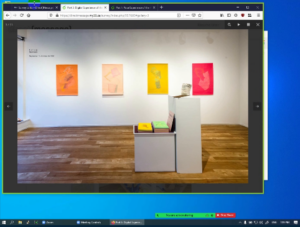What We Learned Trying to Recreate an Open Studio Online

Simon Lebrun — January 2024
“Anyone who has never made a mistake has never tried anything new.” ― Albert Einstein
Sitelines was a community arts project developed by Centre[3] and the Mental Health Rights Coalition. It offered free arts-based workshops to adults with lived experience of mental health and addiction.
(sitelines video https://www.youtube.com/watch?v=dpylj45YrZA)
As the research and consultation phases of the direct[message] project progressed and we moved into the full pandemic lockdowns of 2021 and 2022 it was becoming very clear that older adults were missing the arts and social activities that they had previously been doing in-person, that some were interested in what technology could offer as an alternative, and that what the technology offered an experience that was wanting in frustrating and unexpected ways.
Project participants repeatedly told us that learning new art-making skills and making social connections were two important components of arts programming that they were missing, and that they saw these as areas where new and existing technology might be usefully employed.
In a brainstorming session at the start of a project iteration, where the team evaluated findings to date and refined plans for the next development steps, the team considered what program models they knew that best met these two goals of skill-building and connection-making. And Sitelines was mentioned.
The Sitelines project provided an open studio in downtown Hamilton. There were set-aside hours on specific days when the studio space was open for participants to drop in, and art materials were provided within the space. Professional artists provided instruction and mentoring in the studio space, but participants were welcome to come in and work when they wanted at a pace that suited them. It was the same times every week, so people could fall into a routine and get to know the other artists in a relaxed atmosphere.
What direct[message] needed was a virtual open studio.
“You need to have sufficient courage to make mistakes. Disappointment, defeat, and despair … show us the way.” ― Paulo Coelho, Brida
Each member of the project team had their professional life thrown online so we shared our varied experiences of “virtual space” with each other. Some of us had attended conferences in Gather, a platform where you control a character like you’re in a video game and move about a 2D conference space, others had used PheedLoop to experience a much more staid digital simulacrum of an academic conference. We were introduced to Mozilla Hubs, a free and accessible first-person 3-D environment that we were so taken with we hosted a few project meetings in it.
Nothing we found improved significantly on the main drawbacks older adults reported for Zoom, Teams, WebEx, Jitsi, and Skype except for novel approaches that added technological or conceptual requirements that were prohibitive. (Online meeting platforms that involved navigating an avatar in order to select people or spaces were particularly frustrating for older adults who didn’t have experience with the video games that those platforms’ developers very obviously grew up playing.
As Zoom was what people seemed to be turning to, we looked at ways we could shape a Zoom meeting so that it felt more like a Sitelines open studio than a college classroom or a corporate staff meeting. Packing up and shipping art supply kits out was a big help; adding more time to a virtual session and grouping many sessions into a virtual series also brought a bit more humanity into the shared space. The time we pushed the Zoom envelope furthest was when we had an artist-facilitator and a technician roaming up and down James Street North during a Friday art crawl, broadcasting audio and video of the street scene and interviews with artists to viewers on zoom who could interact with the host and ask their own questions of the interviewees.
“Success does not consist in never making mistakes but in never making the same one a second time.” ― George Bernard Shaw
Sadly, as fun as that was, we still hit up hard against some of the limitations of a Zoom meeting. For example, an art crawl is loud. And it’s loud in a way that you can’t tune out when it’s all being caught by a microphone and fed to you. The connection wasn’t always perfect (but our hats are off to the tech team that made it work and learned a lot doing so). It was a unique experience for someone who hadn’t had a chance to venture downtown on an art crawl night, but for those who’d previously been there in the frenzy, there was something disappointing about how the live experience was attenuated by the teleconference window.
We were very pleased with the connection we made, the experiments we tried, and the new capacity we’ve developed together; we just also want to acknowledge that not every plan will work out, and sometimes you can’t beat being there. Much as we wanted to recreate some of the magic of the Sitelines open studio in a virtual space, that goal eluded us.
As we debate amongst ourselves whether a virtual open studio of this kind is impossible by its nature, is on the horizon on the back of emerging virtual reality technologies, or is achievable today with a bit more trial and error (we don’t always agree!) we want to leave you with the assurance that much can be learned in the effort, even if you don’t get exactly where you aimed.
Simon Lebrun was the project coordinator (phases 3 to 5) and a platform developer with the direct[message] project. He works with Centre[3], an artist-run centre in Hamilton, Ontario.
